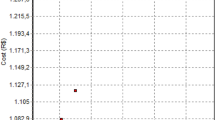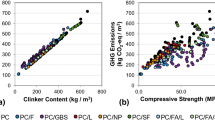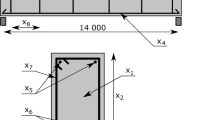Abstract
A procedure is developed for the design of reinforced concrete footings subjected to vertical, concentric column loads that satisfies both structural requirements and geotechnical limit states using a hybrid Big Bang-Big Crunch (BB-BC) algorithm. The objectives of the optimization are to minimize cost, CO\(_{2}\) emissions, and the weighted aggregate of cost and CO\(_{2}\). Cost is based on the materials and labor required for the construction of reinforced concrete footings and CO\(_{2}\) emissions are associated with the extraction and transportation of raw materials; processing, manufacturing, and fabrication of products; and the emissions of equipment involved in the construction process. The cost and CO\(_{2}\) objective functions are based on weighted values and are subjected to bending moment, shear force, and reinforcing details specified by the American Concrete Institute (ACI 318-11), as well as soil bearing and displacement limits. Two sets of design examples are presented: low-cost and low-CO\(_{2}\) emission designs based solely on geotechnical considerations; and designs that also satisfy the ACI 318-11 code for structural concrete. A multi-objective optimization is applied to cost and CO\(_{2}\) emissions. Results are presented that demonstrate the effects of applied load, soil properties, allowable settlement, and concrete strength on designs.













Similar content being viewed by others
References
American Concrete Institute (1991) Standard practice for selecting proportions for normal, heavyweight and mass concrete. ACI 211.1–91
American Concrete Institute (2011) Building code requirements for structural concrete and commentary. ACI 318–11
American Society of Civil Engineers (2010) Minimum design loads for buildings and other structures. ASCE/SEI 7–10
Camp CV (2007) Design of space trusses using big-bang-big crunch optimization. J Struct Eng 133(7):999–1007
Camp CV, Bichon BJ (2004) Design of space trusses using ant colony optimization. J Struct Eng 130(5):741–751
Camp CV, Akin A (2012) Design of retaining walls using big bang-big crunch optimization. J Struct Eng 138(3):438–448
Camp CV, Huq F (2013) CO2 and cost optimization of reinforced concrete frames using a big bang-big crunch algorithm. Eng Struct 48:363–372
Camp CV, Pezeshk S, Hansson H (2003) Flexural design of reinforced concrete frames using a genetic algorithm. J Struct Eng 129(1):1–11
Coello CA (1999) A comprehensive survey of evolutionary-based multiobjective optimization techniques. Knowl Inf Syst 1:269–308
Coello CA, Christiansen AD, Santos F (1997) A simple genetic algorithm for the design of reinforced concrete beams. Eng Comput 13:185–196
Erol OK, Eksin I (2006) A new optimization method: big bang-big crunch. Adv Eng Softw 37:106–111
Galton F (1907) Vox Populi. Nature 75:450–451
Govindaraj V, Ramasamy JV (2005) Optimum detailed design of reinforced concrete continuous beams using genetic algorithms. Comput Struct 84:34–48
Kaveh A, Talatahari S (2009) Size optimization of space trusses using big bang-big crunch algorithm. Comput Struct 87:1129–1140
Kaveh A, Talatahari S (2010) A discrete big bang-big crunch algorithm for optimal design of skeletal structures. Asian J Civil Eng 11(1):103–122
Khajehzadeh M, Taha MR, El-Shafie A, Eslami M (2011) Modified particle swarm optimization for optimum design of spread footing and retaining wall. J Zheijiang Univ-Sci A (Appl Phys Eng) 12(6):415–426
Kwak HG, Kim J (2008) Optimum design of reinforced concrete plane frames based on predetermined section database. Comput Aided Des 40:396–408
Kwak HG, Kim J (2009) An integrated genetic algorithm complemented with direct search for optimum design of RC frames. Comput Aided Des 41:490–500
Lee CL, Ahn J (2003) Flexural design of reinforced concrete frames by genetic algorithm. J Struct Eng 129(6):762–774
Lepš M, Šejnoha M (2003) New approach to optimization of reinforced concrete beams. Comput Struct 81:1957–1966
Marler RT, Arora JS (2004) Survey of multi-objective optimization methods for engineering. Struct Multidisc Optim 26:369–395
Mehta PK (2002) Greening of the concrete industry for sustainable development. In: Concrete International, July 23–28
Mehta PK, Merman H (2009) Tools for reducing carbon emissions due to cement consumption. In: Structure, January 11–15
Mineral Products Association (2010) Summary data. www.mineralproducts.org/sustainability/data.html. 2 August 2012
Parsopoulos KE, Vrahatis MN (2002) Particle swarm optimization method in multiobjective problems. In: ACM symposium on applied computing SAC, Madrid, Spain, pp 603–607, March 10–14
Paya I, Yepes V, González-Vidosa F, Hospitaler A (2008) Multiobjective optimization of concrete building frames by simulated annealing. Comput-Aided Civil Infrastruct Eng 23(8):596–610
Paya-Zaforteza I, Yepes V, Hospitaler A, González-Vidosa F (2009) CO2-optimization of reinforced concrete frames by simulated annealing. Eng Struct 31:1501–1508
Perea C, Alcala J, Yepes V, González-Vidosa F, Hospitaler A (2008) Design of reinforced concrete bridge frames by heuristic optimization. Adv Eng Softw 39:676–688
Poulos HG, Davis EH (1974) Elastic solutions for soil and rock mechanics. Wiley, New York
Rafiqa MY, Southcombea C (1998) Genetic algorithms in optimal design and detailing of reinforced concrete biaxial columns supported by a declarative approach for capacity checking. Comput Struct 69:443–457
Rajeev S, Krishnamoorthy CS (1998) Genetic algorithms-based methodology for design optimization of reinforced concrete frames. Computer-Aided Civil Infrastruct Eng 13:63–74
Sahaba MG, Ashourb AF, Toropovc VV (2004) Cost optimisation of reinforced concrete flat slab buildings. Eng Struct 27:313–322
Sarma KC, Adeli H (1998) Cost optimization of concrete structures. J Struct Eng 124(5):570–578
Suman (2004) Study of simulated annealing based algorithms for multiobjective optimization of a constrained problem. Comput Chem Eng 28:1849–1871
United Nations Intergovernmental Panel on Climate Change (2007). In: Core Writing Team, Pachauri RK, Reisinger A (eds) Climate Change (2007): Synthesis report. Contribution of working groups I, II and III to the fourth assessment report of the Intergovernmental Panel on Climate Change. IPCC, Geneva, Switzerland
Vesic AS (1975) Bearing capacity of shallow foundations. In: Winterkorn H, Fang HY (eds) Foundation engineering handbook, Chap 3. Van Nostrand Reinhold, New York
Villalba P, Alcalá J, Yepes V, González-Vidosa F (2010) CO2 optimization of reinforced concrete cantilever retaining walls. In: 2nd International Conference on Engineering Optimization, September 6–9. Lisbon, Portugal
Wang Y (2009) Reliability-based economic design optimization of spread foundations. J Struct Eng 135(7):954–959
Wang Y, Kulhawy FH (2008) Economic design optimization of foundations. J Geotech Geoenviron 134(8):1097–1105
Whitman RV, Richart FE (1967) Dynamic procedures for dynamically loaded foundations. J Soil Mech Found Div 93(SM6):169–193
Yepes V, González-Vidosa F, Alcalá J, Villalba P (2012) CO2 optimization design of reinforced concrete cantilever retaining walls based on a VNS-threshold acceptance strategy. J Comput Civ Eng 26(3):378–386
Acknowledgements
We are grateful to Dr. Roger Meier and Mr. Daniel Rocha, P.E. for providing constructive comments and guidance during the course of this study.
Author information
Authors and Affiliations
Corresponding author
Rights and permissions
About this article
Cite this article
Camp, C.V., Assadollahi, A. CO 2 and cost optimization of reinforced concrete footings using a hybrid big bang-big crunch algorithm. Struct Multidisc Optim 48, 411–426 (2013). https://doi.org/10.1007/s00158-013-0897-6
Received:
Revised:
Accepted:
Published:
Issue Date:
DOI: https://doi.org/10.1007/s00158-013-0897-6




